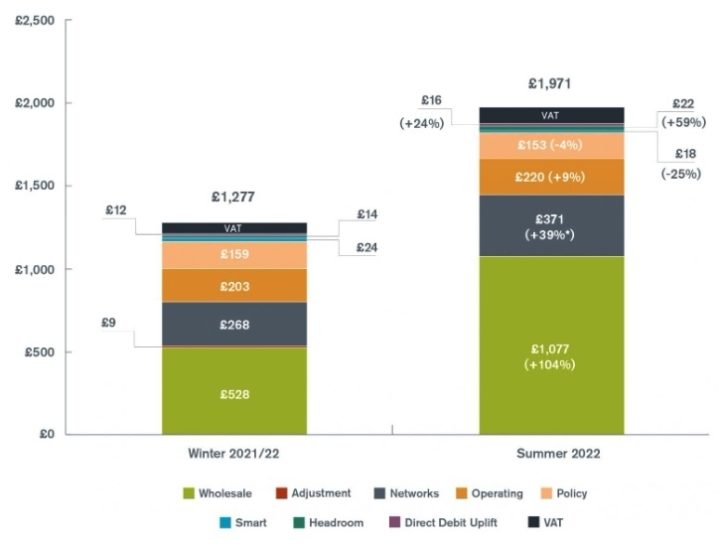Energy bills: getting the balance right
Rebalancing levies on energy bills is seen as an enabler of clean heat, what could it look like?

By Jess Ralston
@jessralston2Share
Last updated:
Measures to move levies from electricity to gas bills have been under discussion for some time.
The disparity between fuel costs is one of the biggest barriers to the Government’s aim of cleaning up domestic heat, and doesn’t reflect how much electricity generation has decarbonised in recent years.
As it stands, each kilowatt hour (kWh) of electricity we use at home costs around 28p, compared to around 7p for gas. Despite the superior efficiency of heat pumps, which produce three to four times as much heat per kWh consumed, this disparity has an impact on running costs, essentially subsidising the technology that pollutes our homes with harmful air pollution and our sky with carbon dioxide.
But what could rebalancing levies on bills look like, and what might it mean for domestic customers?
Levies
As it stands, around 12% of electricity bills (£119/year per home) are made up of ‘environmental and social levies’, compared to just 3.4% of gas bills (£33/year per home).

These levies pay for various policies that either support clean energy (Renewables Obligation, Feed-in-Tariffs, Contracts for Difference), help with social issues such as fuel poverty (Warm Homes Discount that offers direct payments to help with bills) or both (the Energy Company Obligation, which supports insulating homes to cut bills). A very small amount goes to support high network costs in remote regions such as the Scottish Highlands and to support the roll out of ‘green’ gas.
Many years ago, Ofgem decided to place these costs solely on electricity bills as a means of avoiding free-riders; 99.7% of homes in the UK are on the power network compared with 86% on the gas grid. Of course, any rebalancing of levies will need to be carefully managed so that those only using gas are not penalised, but there is a very small number of these households.
Yet as times have changed, levies haven’t changed with them. The rapid decarbonisation of the power sector – carbon intensity is down by over half from 535g/kWh in 2008 to 187g/kWh in 2021 – means this set up is increasingly hard to justify. The Contracts for Difference levy is now less than 50p per bill per year, as it has done its job in the early years and renewables have reduced so rapidly in cost that they are now the cheapest form of generation by a long shot.
Shifting some or all levies from a cleaner fuel to a dirtier one ensures that the more polluting fuel carries a higher cost – and it makes sense when incentivising the switch to clean heat.
Where next?
There are a number of options for policy makers. First up is directly moving some of the levies onto gas bills instead of electricity, crucially leaving overall dual fuel bills unchanged.
A good starting point here is the Renewables Obligation, an environmental levy brought in to support early renewable projects when costs were higher than they are now – a scheme so successful that now offshore wind is the powerhouse of the UK’s energy system, providing one of the cheapest forms of energy and helping to cushion the increase in expensive gas generation.
Switching the Renewables Obligation onto gas would lower electricity bills by around £75 per year, and bring the unit price of electricity down to 26p/kWh (-9%). Gas would rise to 8p/kWh in it’s place (+8%), but crucially the overall dual fuel bill would still stay the same.
The next step could be repeating this process with the Feed in Tariff levy – another past scheme that successfully saw the UK’s rooftops adorned with solar panels to allow families to take charge of their own energy. Switching this levy too would not only further bring together fuel prices, but would significantly equalise effective carbon prices borne by domestic energy and gas.
Combined, the Renewables Obligation and Feed-in Tariff being shifted to gas would lower electricity unit prices by -11%, to 25p/kWh, while gas would stick at 8p/kWh. Most importantly in the cost of living crisis, overall bills will stay the same, yet a strong message has been sent to the public and to investors that cleaner electricity is the direction of travel.
Overall, switching these two ‘legacy’ environmental schemes and the social schemes – which support bill reducing insulation installations in vulnerable households or directly help people pay bills – would reduce the unit price of electricity by 14% (to 24p/kWh, while gas would still cost 8p/kWh (+13%).
| Levy | Cost on typical electricity bill (£987) | Cost on typical gas bill (£983) | Proportion of total environmental and social levies |
|---|---|---|---|
Renewables Obligation | £75 | £0 | 49% |
Feed-in Tariff | £18 | £0 | 11% |
Contracts for Difference | £0.3 | £0 | 0% |
Green gas levy | £0 | £3 | 2% |
AAHEDC | £1 | £0 | 1% |
Energy Company Obligation | £16 | £21 | 24% |
Warm Homes Discount | £10 | £10 | 12% |
TOTAL | £119.3 | £34 | 99% (not 100% due to rounding) |
For another route, the Government may look to their 2017 Cost of Energy Review. Instead of a swapping onto gas bills, independent expert Professor Helm suggests that ring-fenced ‘legacy costs’ could be paid for through general taxation.
The effect on electricity bills would be largely the same as in the approach detailed above, falling by £92 as the legacy environmental tariffs (RO and FiT) were borne elsewhere. However, with these costs shifted to general taxation, their bill would be footed in a more progressive manner, with higher earners contributing more.
Stepping stone
Rebalancing these costs is seen as essential in the move to clean heat. Industry, the Climate Change Committee and independent experts commissioned by the Government itself have called for this shift in policy for years.
Of course, especially in the current climate care is needed should these levies be moved, ensuring they are done gradually and to ensure some families, those more dependent on gas for example, do not face higher bills than expected.
But there are very practical ways to this while keeping overall bills the same. It’s now a matter of a government being bold enough to do so. The Government’s new Boiler Upgrade Scheme helps tackle the upfront cost of clean heat, but making the running costs fairer – and representative of the UK’s power system in 2022 – is equally as vital to ramping up heat decarbonisation, with most of the solutions in plain sight.
Notes:
Calculations based on typical gas use in the home being 12,000kWh per year and typical electricity use between 2,900kWh (for unrestricted customers) per year.
Share